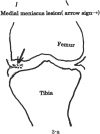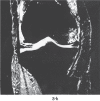Low Level Laser Therapy for chronic knee joint pain patients
- PMID: 25705083
- PMCID: PMC4331569
- DOI: 10.5978/islsm.14-OR-21
Low Level Laser Therapy for chronic knee joint pain patients
Abstract
Background and aims: Chronic knee joint pain is one of the most frequent complaints which is seen in the outpatient clinic in our medical institute. In previous studies we have reported the benefits of low level laser therapy (LLLT) for chronic pain in the shoulder joints, elbow, hand, finger and the lower back. The present study is a report on the effects of LLLT for chronic knee joint pain.
Materials and methods: Over the past 5 years, 35 subjects visited the outpatient clinic with complaints of chronic knee joint pain caused by the knee osteoarthritis-induced degenerative meniscal tear. They received low level laser therapy. A 1000 mW semi-conductor laser device was used to deliver 20.1 J/cm(2) per point in continuous wave at 830nm, and four points were irradiated per session (1 treatment) twice a week for 4 weeks.
Results: A visual analogue scale (VAS) was used to determine the effects of LLLT for the chronic pain and after the end of the treatment regimen a significant improvement was observed (p<0.001). After treatment, no significant differences were observed in the knee joint range of motion. Discussions with the patients revealed that it was important for them to learn how to avoid postures that would cause them knee pain in everyday life in order to have continuous benefits from the treatment.
Conclusion: The present study demonstrated that 830 nm LLLT was an effective form of treatment for chronic knee pain caused by knee osteoarthritis. Patients were advised to undertake training involving gentle flexion and extension of the knee.
Keywords: Low Level Laser Therapy; activities of daily living; chronic knee joint pain, meniscal tear; knee osteoarthritis; posture education.
Figures




Similar articles
-
Low Level Laser Therapy in patients with chronic foot and ankle joint pain.Laser Ther. 2017 Mar 31;26(1):19-24. doi: 10.5978/islsm.17-OR-2. Laser Ther. 2017. PMID: 28740325 Free PMC article.
-
Low level laser therapy for patients with cervical disk hernia.Laser Ther. 2012 Sep 30;21(3):193-7. doi: 10.5978/islsm.12-OR-10. Laser Ther. 2012. PMID: 24511189 Free PMC article.
-
The effect of low level laser therapy for pain in major muscles controlling two joints.Laser Ther. 2019 Jun 30;28(2):111-115. doi: 10.5978/islsm.19-OR-07. Laser Ther. 2019. PMID: 32921909 Free PMC article.
-
Low level laser therapy for osteoarthritis and rheumatoid arthritis: a metaanalysis.J Rheumatol. 2000 Aug;27(8):1961-9. J Rheumatol. 2000. PMID: 10955339
-
Review of Literature on Low-level Laser Therapy Benefits for Nonpharmacological Pain Control in Chronic Pain and Osteoarthritis.Altern Ther Health Med. 2018 Sep;24(5):8-10. Altern Ther Health Med. 2018. PMID: 28987080 Review.
Cited by
-
Comparison of Short-Term Effects of Extracorporeal Shock Wave Therapy, Low-Level Laser Therapy and Pulsed Electromagnetic Field Therapy in Knee Osteoarthritis: A Randomized Controlled Study.J Clin Med. 2025 Jan 17;14(2):594. doi: 10.3390/jcm14020594. J Clin Med. 2025. PMID: 39860600 Free PMC article.
-
Molecular and Cellular Mechanisms of Arthritis in Children and Adults: New Perspectives on Applied Photobiomodulation.Int J Mol Sci. 2020 Sep 8;21(18):6565. doi: 10.3390/ijms21186565. Int J Mol Sci. 2020. PMID: 32911717 Free PMC article. Review.
-
Treatment of drug-resistant fibromyalgia symptoms using high-intensity laser therapy: a case-based review.Rheumatol Int. 2018 Mar;38(3):517-523. doi: 10.1007/s00296-017-3856-5. Epub 2017 Oct 28. Rheumatol Int. 2018. PMID: 29080932 Review.
-
Effects of low-level laser therapy on acupuncture points on knee pain and function in knee osteoarthritis.Rev Assoc Med Bras (1992). 2023 Dec 22;70(1):e20230264. doi: 10.1590/1806-9282.20230264. eCollection 2023. Rev Assoc Med Bras (1992). 2023. PMID: 38126411 Free PMC article.
-
Efficacy of Acupoints Dual-Frequency Low-Level Laser Therapy on Knee Osteoarthritis.Evid Based Complement Alternat Med. 2020 Sep 24;2020:6979105. doi: 10.1155/2020/6979105. eCollection 2020. Evid Based Complement Alternat Med. 2020. PMID: 33029170 Free PMC article.
References
-
- Harada T, Motegi M, Morisu M, et al. (1989). The Line of Gravity in the Relaxed Standing Position. Jpn J Appl Physiol 19:525-532.
-
- Ohkuni I, Harada T. (2002). Knee joint pain and rehabilitation. Pain Clinic 23:493-500 (in Japanese).
-
- Tsuchiya K, Kawatani M, Takeshige C. (1994). Laser Irradiation Abates Neuronal Responses to Nociceptive Stimulation of Rat-paw Skin. Brain Res Bull 34:369-374. - PubMed
-
- Maekawa Y, Hosokawa T, Itoh T. (2000). Effects of near infrared low level laser irradiation on micro-circulation. Laser Surg Med 27:427-437. - PubMed
-
- Fahmy NR, Williams EA, Noble J. (1983). Meniscus pathology and osteoarthritis of the knee. J Bone Joint Surg Br 65:24-28. - PubMed
LinkOut - more resources
Full Text Sources
Other Literature Sources
Medical
Miscellaneous
